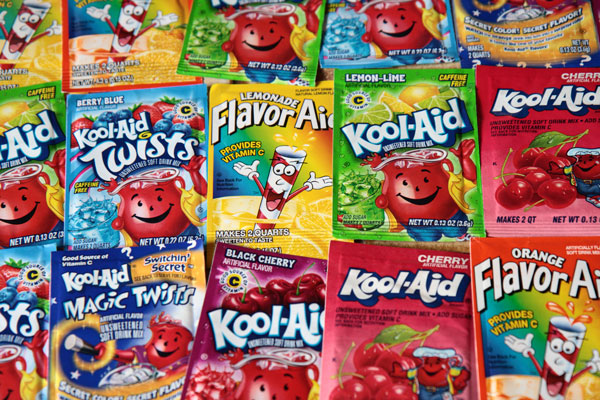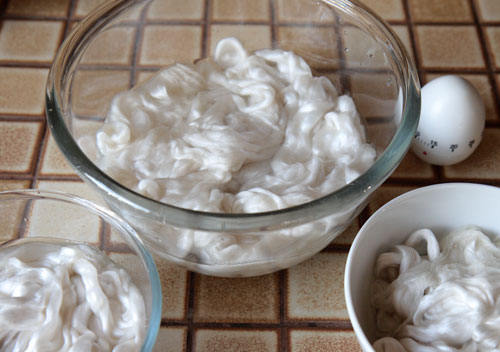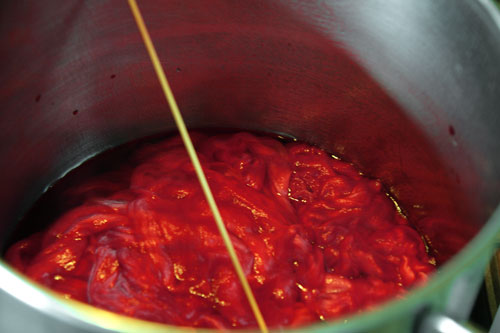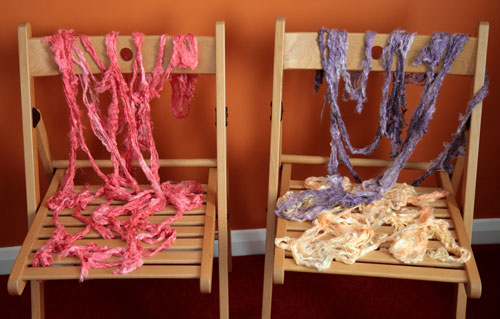Kool Aid experiments
1 commentI’ve always been put off dyeing yarn because my experience of dyeing fabric is that it’s either expensive (with machine dyes) or messy (with immersion dyes). However, the temptation to dye my new silk tops for spinning was just too great: enter the Kool Aid.

Kool Aid in a multitude of flavours
Kool Aid is a disgustingly artificial powdered drink from the US that comes in range of colours / ‘fruit’ flavours. Anyone who drinks the stuff no doubt has multi-coloured innards and ADHD. It will dye any kind of protein-based (animal) fibres (including silk). Research suggests that it is also possible to dye plant-based fibres with Kool Aid but additional chemicals are required. It’s easy to see why Kool Aid is so popular for dyeing: it’s cheap, easy, non-toxic (drink at your own risk), comes in managable-sized sachets and produces an array of bright colours. Kool Aid dyeing requires nothing more than standard kitchen equipment and white vinegar. It is not widely available in the UK but Kool Aid World has a good selection, for about £0.60 per sachet.
There is no shortage of instructions for Kool Aid dyeing on the internet, but because it’s predominantly available in the US, they all list quantities in units we don’t use in the UK (quarts, anyone?), so I’ve supplied metric units for the benifit of fellow Europeans.
My instructions are for dyeing batches in semi-solid colours, you can also use Kool Aid for hand-painted and self-striping yarns. I dyed three batches at once; grape, cherry and lemonade (with a hint of orange). I managed to complete the whole prcess without acidentally dyeing myself or my kitchen.
Texere sell a wide range of yarns for dyeing. Along with my silk tops, I dyed a little of their 4 ply Bluefaced Leicester (code DY280) to keep for colour samples.
What you need
Per 100g of yarn/fibre:
- 4 packs of Kool Aid or Flavor Aid (more if you want a good yellow from the ‘Lemonade’ colour, it’s not very strong)
- 225 ml white vinegar
- 675 ml water
Equipment
- Bowl large enough to soak your fibre/yarn
- Big streel saucepan with lid (don’t use aluminium, it will react with the acid)
- Plastic implement
- Measuring jug
- Kitchen timer
- Rubber gloves
- Apron
- Old towel
There’s some disagreement about whether the vinegar is necessary. This is an acid dying process – the acid is required to set the dye and make it fast – but Kool Aid is already quite acidic as it’s high in citric and ascorbic acid. I decided to err on the side of caution and add the vinegar.
You can mix different flavours to give different shades, but at first you might want to use each one separately so you can build up your own colour chart. Be sure to make a note of which flavours you use, and how many packs for later reference.
Method
- If using yarn, wind it into loosely tied hanks. Soak the yarn or fibre in lukewarm water for 20 mins. Drain and gently squeeze out the excess water, don’t wring or it might start to felt. Soaking ensures that the dye is absorbed more evenly. Skip this stage if you want a very mottled effect.

Soaking the fibre
- Measure out the water and vinegar in a measuring jug and pour into the pan. Add the Kool Aid powder (being careful not to inhale it). Stir thoroughly with a plastic implement making sure that the dye is evenly mixed.

Mixing the dye – grape (left), lemonade (right)
- Add the yarn/fibre to the mixture, gently agitate and turn using the plastic implement to help the dye take evenly. Add more water if necessary to ensure it’s all covered. Turn on the heat and bring the pan to simmering point. Simmer gently for 10 mins, do not agitate the yarn/fibre or it may felt.

Fibre in the cherry dye mix (not a pan of entrails)
- Turn off the heat, cover with lid and leave to stand for 30 mins. The liquid should now be clear (or milky white for some flavours) and all the dye absorbed. If it hasn’t fully absorbed, repeat this stage.

The liquid turns clear when all the dye has been absorbed
- Leave the liquid to cool with the lid off. Once lukewarm, rinse the yarn/fibre with water of the same temperature (cold water might ‘shock’ the yarn and cause felting).
- When the water runs clear, drain the yarn/fibre, gently squeeze out the water. Roll the yarn/fibre up in an old towel and absorb the excess moisure and leave for an hour or so. Lay out the yarn/fibre to dry.

Silk tops drying
Results

Wool yarn swatches with dye recipes noted
I found that the wool took the dye much more evenly than the silk and the colours are stronger. The colours differ slightly between the wool and silk – as you can see from the swatches, the silk took on a slightly bluer shade than the wool with the cherry and grape flavours.
It really is as easy as people say. Have a go, I dare you.
Useful links
- Kool Aid colour chart
- Kool Aid colour chart showing mixed colours and stronger concentrations
- Self-striping yarn with Kool Aid by Eunny Jeng
- Kool Aid dyeing on Knitty
- Kool Aid World – buy Kool Aid in the UK
- Texere – yarns for dyeing
Kool! I used to eat the powder straight from the packet–the “sugar free” varieties already have some nasty chemical sweetener right in the packet. And I definitely inhaled accidentally on several occasions. Thankfully I’ve eaten only 2-3 packets’ worth, otherwise your yarn made me worried I’d dyed my insides forever! Love the purple color the most, although the yellow is so pretty and springy too.